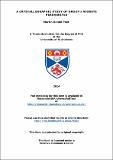Files in this item
A crystallographic study of group I niobate perovskites
Item metadata
| dc.contributor.advisor | Ashbrook, Sharon E. | |
| dc.contributor.advisor | Lightfoot, Philip | |
| dc.contributor.author | Peel, Martin D. | |
| dc.coverage.spatial | xvi, 232 | en_US |
| dc.date.accessioned | 2015-04-22T12:39:05Z | |
| dc.date.available | 2015-04-22T12:39:05Z | |
| dc.date.issued | 2015-06-24 | |
| dc.identifier | uk.bl.ethos.644849 | |
| dc.identifier.uri | https://hdl.handle.net/10023/6530 | |
| dc.description.abstract | In this work, X-ray and neutron powder diffraction experiments and complementary solid-state NMR spectroscopy are used to characterise NaNbO₃-based perovskite phases. Samples of NaNbO₃, KₓNa₁₋ₓNbO₃ and LiₓNa₁₋ₓNbO₃ are synthesised using a variety of techniques and subsequently characterised. For NaNbO₃, it is observed that at least two room temperature perovskite phases can co-exist, P and Q, and that each phase can be formed exclusively by manipulating the synthetic approach utilised. Phase Q can also be formed by the substitution of a small amount of K⁺ or Li⁺ for Na⁺. The room temperature phases of these materials are also analysed using NMR spectroscopy and X-ray diffraction. It is found that, for KₓNa₁₋ₓNbO₃, preferential A-site substitution of K⁺ for Na⁺ may occur, and this observation is supported using a range of NMR techniques and density functional theory calculations. The high-temperature phase behaviour of NaNbO₃ and KₓNa₁₋ₓNbO₃ (x = 0.03 to 0.08) is analysed using high-resolution neutron and X-ray powder diffraction to determine when phase changes occur and to characterise each phase. Characterisation of these materials is supported used complementary symmetry mode analysis. For the LiₓNa₁₋ₓNbO₃ perovskite system, complex phase behaviour is observed at room temperature. High-resolution neutron powder diffraction data shows that, over the range 0.08 < x < 0.20, phase Q may co-exist with a rhombohedral phase, with the proportions of the two highly dependent upon the synthetic conditions used. Furthermore, using X-ray diffraction and NMR spectroscopy, phase Q is shown to undergo a crystal-to-crystal transition to the rhombohedral phase. For higher values of x, two compositionally-distinct rhombohedral phases are formed, termed Na-R3c and Li-R3c, as determined from neutron powder diffraction data. | en_US |
| dc.language.iso | en | en_US |
| dc.publisher | University of St Andrews | |
| dc.rights | Creative Commons Attribution-NonCommercial-NoDerivatives 4.0 International | |
| dc.rights.uri | http://creativecommons.org/licenses/by-nc-nd/4.0/ | |
| dc.subject | Perovskite | en_US |
| dc.subject | Solid-state NMR | en_US |
| dc.subject | X-ray diffraction | en_US |
| dc.subject | Neutron diffraction | en_US |
| dc.subject | Sodium niobate | en_US |
| dc.subject.lcc | QD181.N3 | en_US |
| dc.subject.lcsh | Niobates | en_US |
| dc.subject.lcsh | Perovskite | en_US |
| dc.subject.lcsh | Nuclear magnetic resonance spectroscopy | en_US |
| dc.subject.lcsh | X-rays--Diffraction | en_US |
| dc.subject.lcsh | Neutrons--Diffraction | en_US |
| dc.title | A crystallographic study of group I niobate perovskites | en_US |
| dc.type | Thesis | en_US |
| dc.type.qualificationlevel | Doctoral | en_US |
| dc.type.qualificationname | PhD Doctor of Philosophy | en_US |
| dc.publisher.institution | The University of St Andrews | en_US |
This item appears in the following Collection(s)
Except where otherwise noted within the work, this item's licence for re-use is described as Creative Commons Attribution-NonCommercial-NoDerivatives 4.0 International
Items in the St Andrews Research Repository are protected by copyright, with all rights reserved, unless otherwise indicated.


